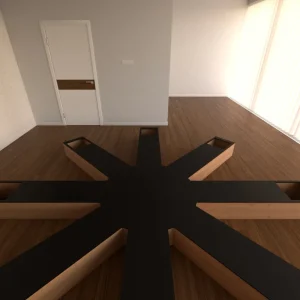The virtual reality environment can be created as per the need of the experiment. In the Simian version multiple environments can be configured.
$1,590.00
The virtual reality environment can be created as per the need of the experiment. In the Simian version multiple environments can be configured.
The Morris Water Maze (MWM) is a widely used behavioral task developed by Richard G. Morris in the year 1981 as a response to the Radial Arm Maze (RAM). As opposed to the Radial Arm Maze, the Morris Water Maze doesn’t provide the subject with a choice point. Further, the task utilizes the fear of drowning to motivate the subject to learn the location of the escape platform quickly. The navigational task is effective in the assessment of spatial learning, and over the course of years has seen modifications and adaptations such as the Water T-Maze, the Water Y-Maze, and the Water RAM.

Simian Labs is a laboratory focused on developing innovative solutions in the field of technology and biotechnology. Specializing in research and development (R&D), Simian Labs works on projects that aim to integrate artificial intelligence with biology to create advanced tools that enhance the understanding of complex biological processes and enable significant advancements in areas such as medicine, pharmacology, and bioinformatics.


bool(false)

bool(false)
The Morris Water Maze (MWM) is a widely used behavioral task developed by Richard G. Morris in the year 1981 as a response to the Radial Arm Maze (RAM). As opposed to the Radial Arm Maze, the Morris Water Maze doesn’t provide the subject with a choice point. Further, the task utilizes the fear of drowning to motivate the subject to learn the location of the escape platform quickly. The navigational task is effective in the assessment of spatial learning, and over the course of years has seen modifications and adaptations such as the Water T-Maze, the Water Y-Maze, and the Water RAM.
The Morris Water Maze has been used for various investigations including endocrine abnormalities, strokes, Alzheimer’s disease, other neurodegenerative diseases, and their effects on learning and memory (Brandeis et al., 1989). The task is also able to differentiate between spatial and non-spatial learning by using visible and hidden platforms. The different possible variations in protocols such as Discrimination learning protocol, Cued learning protocol, and Latent learning protocol (Vorhees and Williams 2006) allow measuring the different specificity of spatial learning and memory.
With the advancements in technology and methodology, the virtual applications of the Morris Water Maze are rapidly evolving. The virtualization of the Morris Water Maze task can be homologous to the rodent MWM, depicting the environment like a pool, or can be analogous in nature, wherein the concept of the MWM is applied in an environment such as a room. The underlying principle of Morris Water Maze is that spatial learning is not dependent on local auditory, visual or olfactory cues (Morris, 1981). The task suggests that the subjects can navigate themselves to the goal platform by utilizing the distal cues.
The virtual environments of the Morris Water Maze task are developed based on the requirements of the investigations. These environments can be analogous or homologous to the traditional Morris Water Maze. Analogous environments usually present a more ethological approach such as presenting a room as in the experiments carried out by Daga et al., 2017 and Livingstone and Skelton (2007). These environments are modeled on the principle of the Morris Water Maze, that is, navigation of space is possible based on distal cues. These environments use objects or markings (such as a green cone or a circular spot on the floor) as an analogy for the Morris Water Maze’s escape platforms. On the other hand, homologous environments use the same design concept as the physical rodent Morris Water Maze. The environment is a pool (Cornwell et al., 2008) that has distal cues present on the walls surrounding the pool.
The earliest use of a virtual Morris Water Maze in humans was by Astur et al. (1998). In their study, they assessed the difference in the performance of male and female participants. The study involved using a 3D computer simulation of the Morris Water Maze that the participants had to navigate using a joystick to find the escape platform.
Similar to the rodent MWM, the participants were assessed in a water pool that had a hidden/visible escape platform, the position of which was kept constant throughout the sessions. Their study was able to conclude that males, in fact, performed significantly better than the female participants in this navigation task.
The virtual Morris Water Maze was also used by Rahman and Koerting (2008) in evaluating if the sexual orientation of the participants contributed to the performance in the spatial memory task. Based on the data, they were able to conclude that no significant difference in performance could be observed between homosexuals and heterosexuals. However, the difference between the sexes could be seen.
Another area explored using the virtual Morris Water Maze is neuropsychiatric disorders’ effect on spatial task performance. In early 2010, Folley and coworkers evaluated the performance of schizophrenic patients in the virtual Morris Water Maze that was presented to them as a pool within a room. Subjects that met the criteria were then evaluated using an fMRI task. From the data analysis, it was concluded that the inefficiency of the schizophrenic patients in allocentric learning and memory could be related to the inability to recruit appropriate task-dependent neural circuits. Another study involved evaluating the performance of depressed individuals in the virtual MWM task (Cornwell et al., 2010). During the task whole-head, magnetoencephalography (MEG) recordings were also performed. The results showed that the depressed individuals performed significantly worse than the controls.
The virtual environments of the Morris Water Maze task can either have multiple cues or a single fixed cue such as the fixed chair in the center of the room in the experiments carried out by Daga et al. (2017). The two types of cue variation allow assessment of allocentric- and egocentric- reference-based navigations.
Advanced technologies allow the creation of rich and immersive environments such as the one created by Schoenfeld et al., 2014. For their virtual adaptation of the Morris Water Maze task, Schoenfeld et al. created an island on which the participants had to find a treasure box. Off-shore elements included a yacht, wind turbine, bridge, and water tower. These elements served as distal cues for their task. Simple environments such as the one used by Kolarik et al., 2018 are also just as effective. Kolarik et al., 2018 environment was a simple 8 x 8 m virtual room that had unique paintings placed unevenly spaced on each of the four walls.
| Brand | ConductScience |
|---|
You must be logged in to post a review.
There are no questions yet. Be the first to ask a question about this product.
Reviews
There are no reviews yet.